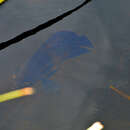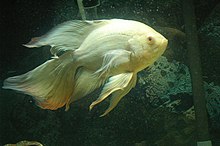en
names in breadcrumbs


Perception Channels: tactile ; chemical
---
As a popular aquarium fish, A ocellatus has some obvious economic importance to humans. Additionally, it has been used by biologists in numerous studies of fish, including studies on behavior, eyesight, auditory systems, and swim bladders.
Although these predators are not at all choosy, they feed mostly on insect larvae and smaller fish. Their feeding habits require that Oscars have excellent eyesight. Because of this, they have been the subject of numerous studies concerning eyesight in fish. (The Aquarium Encyclopedia, 1983, Andison and Sivak, 1996)
These fish are found in the Amazon River basin, from the Orinoco River to the Rio Paraguay, throughout Venezuela, Guyana, and Paraguay. (The Aquarium Encyclopedia, 1983.)
Biogeographic Regions: neotropical (Native )
Found in the tropical lowlands of South America, A. ocellatus prefers the floodplains and swamps of the Amazon River basin. They are most comfortable in water about 25 degrees Celsius, or slightly higher for breeding. (Kullander, 1996)
Aquatic Biomes: rivers and streams
Compared to other fishes, Astronotus ocellatus has a slender, laterally compressed body, and a blunt head with a large mouth and protruding jaw. Colors vary greatly among geographic regions and individuals, but most are dark green to black, with red stripes along its back and a red circle on the base of the tail fin. The adult fish grows up to 35 cm long. Males and females are visually indistinguishable. (Gracyalny, 1996.)
Range mass: 2 to 4 kg.
Other Physical Features: bilateral symmetry
Though they can become much larger, A. ocellatus are sexually mature soon in life, usually by the time they are 12 cm long. These fish exhibit a high degree of parental care. After spawning in open water, the eggs are laid on a piece of ground that has been cleared by one of the parents. After three or four days, the eggs hatch. The brood is then transported to a sandy hollow for about one week. Young fish have been observed clinging to their parents with their mouths, even after they are able to swim freely. (The Aquarium Encyclopedia, 1983)
The oscar (Astronotus ocellatus) is a species of fish from the cichlid family known under a variety of common names, including tiger oscar, velvet cichlid, and marble cichlid.[1] In tropical South America, where the species naturally resides, A. ocellatus specimens are often found for sale as a food fish in the local markets.[2][3] The fish has been introduced to other areas, including India, China, Australia, and the United States. It is considered a popular aquarium fish in Europe and the U.S.[4][5][6]
The species was originally described by Louis Agassiz in 1831 as Lobotes ocellatus, as he mistakenly believed the species was marine; later work assigned the species to the genus Astronotus.[7] The species also has a number of junior synonyms: Acara compressus, Acara hyposticta, Astronotus ocellatus zebra, and Astronotus orbiculatus.[8]
A. ocellatus examples have been reported to grow to about 45 cm (18 in) in length and 1.6 kilograms (3.5 lb) in weight.[1] The wild-caught forms of the species are typically darkly coloured with yellow-ringed spots or ocelli on the caudal peduncle and on the dorsal fin.[5] These ocelli have been suggested to function to limit fin-nipping by piranha (Serrasalmus spp.), which co-occur with A. ocellatus in its natural environment.[7][9] The species is also able to rapidly alter its colouration, a trait which facilitates ritualised territorial and combat behaviours amongst conspecifics.[10] Juvenile oscars have a different colouration from adults, and are striped with white and orange wavy bands and have spotted heads.[7]
A. ocellatus is native to Brazil, Colombia, Ecuador, Guyana, French Guiana, Suriname, Peru, and Venezuela, and occurs in the Amazon River basin, along the Amazon, Içá, Negro, Solimões, and Ucayali River systems, and also in the Approuague and Oyapock River drainages.[1][2] In its natural environment, the species typically occurs in slow-moving white-water habitats, and has been observed sheltering under submerged branches.[5] Feral populations also occur in China,[11] northern Australia,[12] and Florida, USA[13] as a byproduct of the ornamental fish trade. The species is limited in its distribution by its intolerance of cooler water temperatures, the lower lethal limit for the species is 12.9 °C (55.22 °F).[14]
Although the species is widely regarded as sexually monomorphic,[5] males have been suggested to grow more quickly, and in some naturally occurring strains, males are noted to possess dark blotches on the base of their dorsal fins.[6][7] The species reaches sexual maturity around one year of age,[15] and continues to reproduce for 9–10 years.[15] Frequency and timing of spawning may be related to the occurrence of rain.[16] A. ocellatus fish are biparental substrate spawners, though detailed information regarding their reproduction in the wild is scarce.
In captivity, pairs are known to select and clean generally flattened horizontal or vertical surfaces on which to lay their eggs.. Smaller females lay around 300-500 eggs, while larger female oscars can lay about 2,500-3,000 eggs.[15] Like most cichlids, A. ocellatus practices brood care, although the duration of brood care in the wild remains unknown.[6]
The oscar is one of the most popular cichlids in the aquarium hobby.
Oscar fish are omnivores. Most fish eaten by A. ocellatus in the wild are relatively sedentary catfish, including Bunocephalus, Rineloricaria, and Ochmacanthus species.[9] The species uses a suction mechanism to capture prey,[17] and has been reported to exhibit "laying-on-side" death mimicry in a similar fashion to Parachromis friedrichsthalii and Nimbochromis livingstonii.[18][19] Wild oscars also consume shrimp, snails, insects and insect larvae, as well as fruits and nuts on a seasonal basis.[20] The species also has an absolute requirement for vitamin C, and develops health problems in its absence.[21] Captive oscars generally eat fish food designed for large carnivorous fish: crayfish, worms, and insects (such as flies, crickets and grasshoppers).[22]
Oscars will often lay claim to an area of the aquarium and will be very aggressive towards other fish encroaching on their newly established territory inside the aquarium or lake. The size of the territory varies depending on the size and aggressiveness of the fish, and its surroundings. Once the oscar establishes a territory, it will vigorously defend it by chasing away other fish.[23]

A number of ornamental varieties of A. ocellatus have been developed for the aquarium industry. These include forms with greater intensity and quantities of red marbling across the body, albino, leucistic, and xanthistic forms. A. ocellatus with marbled patches of red pigmentation are sold as red tiger oscars, while those strains with the mainly red colouration of the flanks are frequently sold under the trade name of red oscars.[24] The patterning of red pigment differs between individuals. In recent years long-finned varieties have also been developed. The species is also occasionally artificially coloured by a process known as painting.[25]
{{cite web}}: |author= has generic name (help) {{cite journal}}: CS1 maint: multiple names: authors list (link) The oscar (Astronotus ocellatus) is a species of fish from the cichlid family known under a variety of common names, including tiger oscar, velvet cichlid, and marble cichlid. In tropical South America, where the species naturally resides, A. ocellatus specimens are often found for sale as a food fish in the local markets. The fish has been introduced to other areas, including India, China, Australia, and the United States. It is considered a popular aquarium fish in Europe and the U.S.